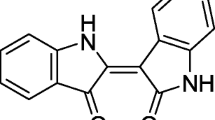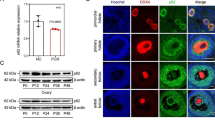Summary
This study examined the effects of Bangdeyun on the expressions of nuclear factor-kappaB (NF-κB), interferon-gamma (IFN-γ) and interleukin-10 (IL-10) in the endometrium of mice with embryo implantation dysfunction (EID) during the implantation time (namely on pregnancy day 5, 6, 7 and 8) and explored the local immune regulatory effects of Bangdeyun. The gestational mice were randomly divided into normal group, model group and Bangdeyun-treated group. EID models of mice were established by using indomethacin. The endometrial expression of NF-κB was detected by immunohistochemistry and Western blotting. IFN-γ and IL-10 were measured by enzyme-linked immunosorbent assay (ELISA). The results showed that in the normal group, NF-κB and IFN-γ were weakly expressed and IL-10 was strongly expressed in the endometrium during the whole implantation period. In the model group, the expressions of NF-κB and IFN-γ were increased on pregnancy day 5, 6 and 7, and IL-10 expression decreased during the whole implantation time when compared with those in the normal group (P<0.01 for all). In the Bangdeyun-treated group, little amount of NF-κB and IFN-γ was expressed and IL-10 expression was strong, much the way they were expressed in the normal group (P>0.05). The expressions of NF-κB and IFN-γ were much lower in the Bangdeyun-treated group than those in the model group on pregnancy day 5, 6 and 7 (P<0.01 for all), while the expression of IL-10 was much higher than in the model group during the whole implantation time (P<0.01). It was suggested Bangderun may favor a shift from Th1- to Th2-type immune response, therefore inhibiting the maternal immune rejection, inducing the immune tolerance and improving the fetal implantation.
Similar content being viewed by others
References
Lin H, Mosmann TR, Guilbert L, et a1. Synthesis of T helper 2-type cytokines at the maternal-fetal interface. J Immunol, 1993,151(9):4562–4573
Wegnumn TG, Lin H, Guilbort L, et al. Bidirectional cytokine interactions in the maternal fetal relationship in successful pregnancy—a Th2 phenomenon. Immunology, 1993,14(7):353–356
Nan CL, Lei ZL, Zhao ZJ, et al. Increased Th1/Th2 (IFN-gamma/IL-4) Cytokine mRNA ratio of rat embryos in the pregnant mouse uterus. J Reprod Dev, 2007,53(2):219–228
Wilczyński JR. Th1/Th2 cytokines balance—yin and yang of reproductive immunology. Eur J Obstet Gynecol Reprod Biol, 2005,122(2):136–143
Chaouat G, Assal-Meliani A, Martal J, et al. IL-10 prevents naturally occurring fetal loss in the CBA×DBA/2 mating combination, and local defeat in IL-10 production in this abortion-prone combination is corrected by in vivo injection of IFN-tau. J Immunol, 1995,154(9):4261–4268
Nakao S, Hata Y, Miura M. Dexamethasone inhibits interleukin-1beta-induced corneal neovascularization: role of nuclear factor-kappaB-activated stromal cells in inflammatory angiogenesis. Am J Pathol, 2007,171(3): 1058–1065
Barrera D, Avila E, Díaz L. Immunological role of progesterone in the maintenance of pregnancy. Rev Invest Clin, 2007,59(2):139–145
Martha L, Minchael P, Harry M. NF-κB regulation of pro-inflammatory cytokines in human gestational tissues in vitro. Biol Reprod, 2002,67(3):668–673
Nakamura H, Kimura T, Ogita K, et al. NF-kappaB activation at implantation window of the mouse uterus. Am J Reprod Immunol, 2004,51(1):16–21
Wu YX, Huang GY. Effect of Bushen Yiqi Huoxue recipe on the expression of estrogen receptor and progesterone receptor. Clin Prog Modern Biomed (Chinese), 2006,6(2):19–22
Wu YX, Huang GY, Gong P. Establishment of indomethacin-induced EID model in mice. Chin pharmacolo Bulletin (Chinese), 2005,21(3):373–375
Banerjee S, Smallwood A, Moorhead J, et al. Placental expression of interferon-gamma (IFN-gamma) and its receptor IFN-gamma R2 fail to switch from early hypoxic to late normotensive development in preeclampsia. J Clin Endocrinol Metab, 2005,90(2):944–952
Kalu E, Bhaskaran S, Thum MY, et al. Serial estimation of Th1:Th2 cytokines profile in women undergoing in-vitro fertilization-embryo transfer. Am J Reprod immunol, 2008,59(3):206–211
Nan CL, Lei ZL, Zhao ZJ, et al. Increased Th1/Th2 (IFN-gamma/IL-4) cytokine mRNA ratio of rat embryos in the pregnant mouse uterus. J Reprod Dev, 2007,53(2): 219–228
Piccinni MP, Romagnani S. Regulation of fetal allograft survival by a hormone-controlled Th1-and Th2-type cytokines. Immunol Res, 1996,15(2):141–150
Szekeres BJ, Wegmann TG. A progestetone-dependent immunomodulatory protein alters the Thl/Th2 balance. J Reprod Immunol, 1996,31(1–2):81–95
Sung MH, Bagain L, Chen Z, et al. Dynamic effect of Bortezomib on NF-kappaB activity and gene expression in tumor cells. Mol Pharmacol, 2008,105(32):11335–11339
Atchison ML, Perry RP. The role of the kappa enhancer and its binding factor NF-kappa B in the developmental regulation of kappa gene transcription. Cell, 1987,48(1):121–128
Atchison ML, Perry RP. The NF-kappa B-binding site mediates phorbol ester-inducible transcription in nonlymphoid cells. Mol Cell Biol, 1988,8(8):3526–3531
Liu M, Ju X, Willmarth NE. Nuclear factor-kappaB enhances ErbB2-induced mammary tumorigenesis and neoangiogenesis in vivo. Am J Pathol, 2009,174(5): 1910–1920
Kim YH, Kim DH, Lim H. The anti-inflammatory effects of methylsulfonylmethane on lipopolysaccharide-induced inflammatory responses in murine macrophages. Biol Pharm Bull, 2009,32(4):651–656
Meng Z, Mitsutake N, Nakashima M, et al. DHMEQ, a novel NF-kappaB inhibitor, enhances anti-tumor activity of taxanes in anaplastic thyroid cancer cells. Endocrinology, 2008, 36(15):4941–4955
Laird SM, Tuckerman EM, Cork BA, et al. Expression of nuclear factor kappa B in human endometrium; role in the control of interleukin 6 and 1IF production. Mol Hum Reprod, 2000,6(1):34–40
Kelly RW, King AE, Critchley HO, et al. Cytokine control in human endometrium. Reproduction, 2001,121(1): 3–19
Hang Y, Peng S, Kuang H. Expression and regulation of dickkopf2 during periimplantation in Mice. J Reprod Dev, 2008,50(4):370–375
Author information
Authors and Affiliations
Additional information
This project was supported by a grant from National Natural Science Foundation of China (No. 30801538).
Rights and permissions
About this article
Cite this article
Wu, Y., Zheng, C., Hu, L. et al. Local immune regulatory effects of Bangdeyun on the endometrium of mice with embryo implantation dysfunction during the implantation time. J. Huazhong Univ. Sci. Technol. [Med. Sci.] 29, 372–376 (2009). https://doi.org/10.1007/s11596-009-0322-y
Received:
Published:
Issue Date:
DOI: https://doi.org/10.1007/s11596-009-0322-y




